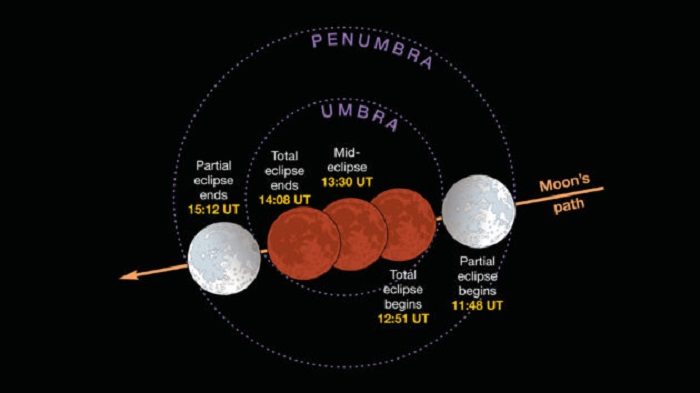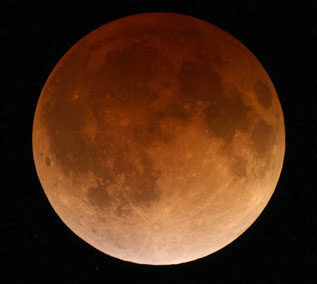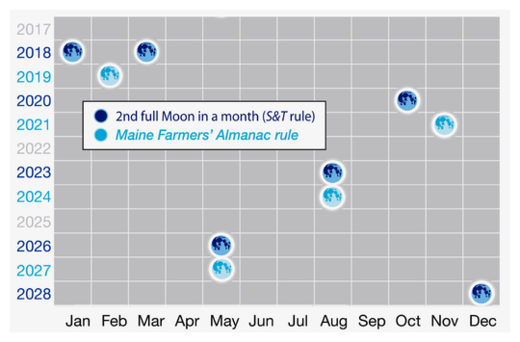
But Wednesday's total lunar eclipse is different. Depending on where you look for news, headlines are calling it a "super blue blood Moon" or "blue blood super moon" - a sky spectacle not seen in more than 150 years!
It's true that January 31st will be a busy day for Luna. First, there is indeed a total lunar eclipse, the first in nearly 2½ years visible anywhere. As we've noted elsewhere, those living near the West Coast and most everywhere around the Pacific Rim will have the best views. The Moon usually takes on a deep red or coppery color during totality, hence the often-used term "blood Moon" to describe its appearance. Those of us stuck on the East Coast of the U.S. will be challenged to see much of anything as the Moon sinks out of sight in the west as the Sun comes up.
Second, this event falls on the second full Moon of the month, what's often called a "Blue Moon." And, third, the eclipse comes just 27 hours after the Moon reaches perigee, its closest orbital point to Earth. Lots of you have no doubt heard this extra-close full Moon called a "super-moon."
Yes, it's an astronomical trifecta. But it's not nearly as rare as you might have heard.

Before 1946, a "blue Moon" never meant the second full Moon in a month. It always meant something else. People used "once in a blue Moon" to mean something that occurs rarely - and, exceedingly rarely, the Moon actually does look blue - when a volcanic eruption, forest fires, or dust storms send lots of fine dust into the atmosphere.
However, the traditional astronomical definition was quite different. The term had been consistently used in the Maine Farmers' Almanac to mean the third full Moon in a season containing four of them (rather than the usual three). This always happened on the 20th, 21st, 22nd, or 23rd day of November, May, February, or August.
But in Sky & Telescope's May 1946 issue, amateur astronomer James Hugh Pruett incorrectly interpreted the almanac's description, and the second-full-Moon-in-one-month usage was born. For more about this historical goof, and how it was discovered, see "What is a Blue Moon?" By either definition, "blue Moons" happen about once every 2.7 years on average.
Using the old, seasonal definition, the last occurrence happened in May 2016 and the next one will come in February 2019. Using the newer definition, we'll enjoy "blue Moons" both during January and again in March. Because of this sequence, there'll be no full Moon at all in February - and that hasn't happened since 1999.
But what about the "once in more than 150 years" that various news stories claim? Well, it's a U.S.-centric thing. For North Americans, the last "blue Moon" total lunar eclipse - one falling on the second full Moon of the month - was indeed a long time ago, on March 31, 1866. (By the way, on that date the Moon was near apogee and therefore nearly as far away as it can be.)

Super-Moon Eclipses
As it goes around us, the Moon's distance from Earth (center to center) varies from about 225,800 miles (363,400 km) at perigee to 252,000 miles (405,550 km) at apogee. So a full Moon that occurs at perigee is usually about 6% bigger and 12% brighter than average. At its orbital extremes, the full Moon at perigee can be up to 14% larger (and appear 30% brighter) than a full Moon at apogee.
Yet even skilled skygazers are challenged to see any difference in size or brightness between an especially close full Moon and an ordinary one. And so it's disingenuous to call something "super" that really isn't. Some other websites make a big deal of the fact that the full Moons of last December 3rd, January 1st, and January 31st are all "super Moons." Aside from especially strong ocean tides, which caused real havoc here in Boston during a major storm on January 4th, these events came and went without much notice.
Many people think the full Moon always looks unusually large when it's near the horizon, an effect known as the "Moon illusion." Images that show a huge full Moon rising dramatically above a city skyline don't match the reality that your eyes see because the camera is magnifying the view. You can gauge the Moon's apparent size at different times using the tip of your finger or a pencil eraser held at arm's length, or by looking at it through a narrow straw. To us, the Moon always looks about ½° across.
For the record, the last time a total lunar eclipse occurred near perigee was . . . the last total lunar eclipse, the one in September 2015. In fact, on that occasion the timing of perigee and the eclipse's midpoint were less than 1 hour apart!



Reader Comments
to our Newsletter